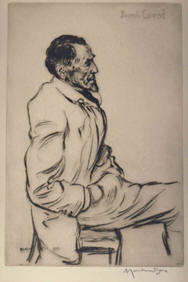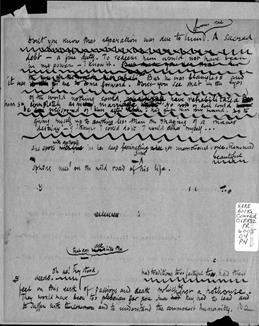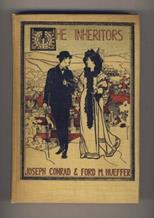Rare
Books
The
Joseph
Conrad
Collection

Bone,
Muirhead.
Joseph Conrad Listening to Music.
Drypoint Engraving.
1923.
 exas
Tech University's in-print collection of
Joseph Conrad
(1857-1924) is perhaps the strongest in the world.
The collection spans Conrad's writing career, from his diary of a journey
up the Congo written in 1890, published after his death in 1925, to "Legends",
written in 1924 and published in Last
Essays in 1926. All told, the
collection consists of more than 1,800 separate volumes, representing all 58 of
Conrad's primary works published in his lifetime, with thirteen copies either
signed or inscribed by Conrad.
exas
Tech University's in-print collection of
Joseph Conrad
(1857-1924) is perhaps the strongest in the world.
The collection spans Conrad's writing career, from his diary of a journey
up the Congo written in 1890, published after his death in 1925, to "Legends",
written in 1924 and published in Last
Essays in 1926. All told, the
collection consists of more than 1,800 separate volumes, representing all 58 of
Conrad's primary works published in his lifetime, with thirteen copies either
signed or inscribed by Conrad.
The collection development policy of the Conrad Collection has been based on the
premise that the first edition of a work is only one part in a process that
began with his manuscripts and ended with his final revised printed text.
Thus, efforts are made to acquire everything from prepublication states,
such as review copies, to all subsequent printings and editions.
In addition, whenever possible and practical, multiple copies of each
printing and edition are acquired.

Page
from Chapter 10 of The Planter of Malata.
Typescript with holograph corrections by Conrad.
Ca. 1913.
The reasoning behind this policy was expressed by Dr. Donald Rude. He wrote in
1987 that "Conrad was a 'fingerer of style,' who eagerly sacrificed not only his
first but his second and sometimes even his third editions as he sought to
perfect his works." This, according
to Rude, "provides the basis for the assemblage of the Texas Tech University
Conrad Collection which contains the largest number of variant impressions of
Conrad's works in a greatest variety of editions than any other scholarly
library."
This offers the Conrad scholar the ability to closely examine multiple copies of
apparently identical texts side by side in order to ascertain any changes
between them. The next step would
be to determine the source of these changes, whether, for example, it was
Conrad, his editor, or a printer, as well as their sequence, in order, as Rude
expressed it, "to trace the evolution of Conrad's texts. . . ."
Although Conrad did not speak English fluently until he was in his twenties, and
always spoke with a marked Polish accent, he is regarded as one of the greatest
novelists in English. Born in 1857
in Berdichev, Ukraine, in 1874, at the age of 16, Conrad was in Marseilles,
France, working as a sailor.
Employed in the British Merchant Marine beginning in 1878, his process of
recreating and idealizing his voyages to the Far East and Australia began even
as he progressed through the ranks of the British Merchant Service.
By 1890 Conrad was carrying with him the chapters of a first novel.
By the time this novel, Almayer's
Folly, appeared in 1895, he had abandoned his life as a sailor for a
precarious existence in England as a writer and family man.
His career was to remain uncertain for nearly twenty years. Despite the
admiration of critics and fellow authors, popular and commercial success eluded
him until the publication of Chance
in 1913.
Critics have divided Conrad's canon into three phases. The first phase comprises
the works from Almayer's Folly through Typhoon (1903).
Based on Conrad's experiences in the Far East, his early work earned him
a reputation as a teller of sea stories.
In the middle phase, from Nostromo (1904) to Under Western Eyes
(1911), Conrad's autobiographical elements are either transformed or
subordinated to more political themes. Conrad's
later work, from Chance (1913) to the posthumous Suspense (1925),
was affected by his declining health and weakening imaginative powers and is
generally considered inferior to his early and middle-period writings.

Front cover to The Inheritors.
New York: McClure, Phillips, 1901.
.
The Works of Conrad Published during his Lifetime
Almayer's Folly.
London: T. Fisher Unwin, 1895.
An Outcast of the Islands.
London: T. Fisher Unwin, 1896.
The Nigger of the "Narcissus".
London: William Heinemann, 1897.
The Lagoon.
New York: Macmillan, 1896.
The Idiots.
New York: Macmillan, 1896.
An Outpost of Progress.
New York: Macmillan, 1896.
Tales of Unrest.
New York: Charles Scribner's Sons, 1898.
Lord Jim.
Edinburgh and London: William Blackwood and Sons, 1900.
The Inheritors.
New York: McClure, Phillips, 1901.
Youth.
Edinburgh and London: William Blackwood and Sons, 1902.
Typhoon and Other Stories.
New York and London: G.P. Putnam's Sons, 1902.
Romance.
London: Smith, Elder & Co., 1903.
Nostromo.
London: George Bell & Sons, 1904.
The Mirror of the Sea.
London: Methuen, 1906.
The Secret Agent.
London: Methuen, 1907.
A Set of Six.
London: Methuen, 1908.
Under Western Eyes.
London: Methuen, 1911.
A Personal Record.
New York: Paul R. Reynolds, 1908.
Some Reminiscences.
London: Eveleigh Nash, 1912.
A Personal Record.
New York and London: Harper & Brothers, 1912.
Twixt Land and Sea.
London: J.M. Dent & Sons, 1912.
Chance.
London: Methuen, 1913.
Within the Tides.
London and Toronto: J.M. Dent
& Sons, 1915.
Victory.
Garden City, N.Y.: Doubleday, Page & Company, 1915.
One Day More.
London: The Beaumont Press, 1917.
The Shadow Line.
London and Toronto: J.M. Dent & Sons, 1917.
Letter from Conrad to S.A. Everitt.
New York: Doubleday, Page & Company, 1918.
The First News.
London: Privately Printed by Clement Shorter, 1918.
Well Done.
London: Privately Printed by Clement Shorter, 1918.
Autocracy and War.
London: Printed for Private Circulation, 1919.
Henry James.
London: Printed for Private Circulation, 1919.
Tradition.
London: Printed for Private Circulation, 1919.
Some Reflexion on the Loss of the Titanic.
London: Printed for Private Circulation, 1919.
Some Aspects of the Admirable Inquiry into the Loss of the Titanic.
London: Printed for Private Circulation, 1919.
The Polish Question.
London: Privately Printed by Clement Shorter, 1919.
The Tale.
London: Privately Printed by Clement Shorter,
1919.
Guy de Maupassant.
London: Printed for Private Circulation, 1919.
London's River.
London: Privately Printed by Clement Shorter, 1919.
My Return to Cracow.
London: Printed for Private Circulation, 1919.
The North Sea on the Eve of War.
London: Printed for Private Circulation, 1919.
The Shock of War.
London: Printed for Private Circulation, 1919.
To Poland in War-Time.
London: Printed for Private Circulation, 1919.
The Arrow of Gold.
London: T. Fisher Unwin, 1919.
The Lesson of the Collision.
London: Richard Clay & Sons, 1919.
Tales of the Sea.
London: Richard Clay & Sons, 1919.
Anatole France.
London: Richard Clay & Sons, 1919.
Alphonse Daudet.
London: Richard Clay & Sons, 1920.
Anatole France "L'Ile des Pingouins".
London: Richard Clay & Sons, 1920.
Books.
London: Richard Clay & Sons, 1920.
Confidence.
London: Richard Clay & Sons, 1920.
An Observer in Malay.
London: Richard Clay & Sons, 1920.
Prince Roman.
London: Richard Clay & Sons, 1920.
The Warrior's Soul.
London: Richard Clay & Sons, 1920.
The Rescue.
Garden City, N.Y.: Doubleday, Page & Company, 1920.
Youth and Gaspar Ruiz.
London and Toronto: J.M. Dent & Sons, 1920.
Notes on Life and Letters.
London and Toronto: J.M. Dent & Sons, 1921.
Notes on my Books.
Garden City, N.Y.: Doubleday, Page & Company, 1921.
Preface to Jessie Conrad's "A Handbook of Cookery".
[England?]: No Publisher Listed, 1921.
The Secret Agent, Drama in Four Acts.
Canterbury: H. J. Goulden, Limited, 1921.
The Black Mate.
Edinburgh: The Dunedin Press, 1922.
Dover Patrol.
Canterbury: H. J. Goulden, Limited, 1922.
John Galsworthy.
Canterbury: H. J. Goulden, Limited, 1922.
The Rover.
Garden City, N.Y.: Doubleday, Page & Company, 1923.
Laughing Anne, a Play.
London: [Morland Press], 1923.
For
additional information, please contact:
Rob E. King
rob.e.king@ttu.edu
(806) 834-0397
